
|
Sale 22
Manuscript and Collectibles Auction
| Lot |
Photo |
Description |
Realized |
Lot 492 |
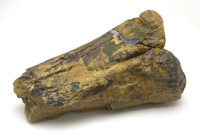 |
20-Pound End Section Of A Duckbill Dinosaur Leg Bone. From Madagascar, Jurassic time period. Everything about this piece adds up to render it a rare and irresistable treasure for the "Jurassic Park" enthusiast. A section of leg bone terminating at the hip joint, broken off (in life) about 13" down the shaft. This breakage was the result of an unfortunate tumble from a cliff into a gulley or ravine. This is, in fact, how a great many fossil preservations came about: accidental death, then a rather rapid entombment of the animal, which in many instances was the result of mudslides or volcanic activity. The contour, color, and sheer massiveness of this specimen are extremely impressive. With old, thick resin coating used to consolidate and protect the fossil surface. Attractive as is, or a conservator could rework the coating.
Estimated Value $500 - 600.
View details and enlarged photo
| Realized
$719 |
Lot 493 |
 |
A School of Fossil Fish-Plus The Teacher! Exquisite and very probably unique grouping of no fewer than 27 fish on the same plate. Twenty-six of the specimens represent the species Armigatus brevissimus, varying in length from about 1 3/4" to 21/2". Also on the plate is a nearly perfect example of the very odd, unusual, rare, almost cartoonish Palaeobalistum, a wide-bodied, sad-eyed creature that appears straight out of central casting for a role in Finding Nemo. This big specimen is a robust 8"-plus in length and over 6" from top fin to lower fin. All contained on a slab of remarkably thin (to reduce the weight) limestone. From the Sublithographic Limestone formation of Hajoula, Lebanon, an area rich in unusual fossils which sometimes--as in this instance--produces a VERY unusual find. Middle Cretaceous period, circa 125 million years ago.
Estimated Value $350 - 450.
View details and enlarged photo
| Realized
$575 |
Lot 494 |
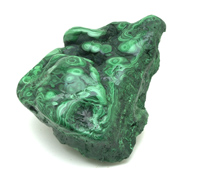 |
Absolutely Gorgeous, Exceptional Quality 27 Pound Chunk Of Finest Zaire (Africa) Malachite. Universally known for its use in jewelery, malachite of the quality seen in pentants --normally of an inch or 1 1/2" in diametere--is the exception rather than the rule. The vast majority of mined malachite is not only of a rough texture (due to admixtures of copper and other ores) but lacks the mullti shades of green interplaying one with the other in bewitching fantasy patterns. Much of the mined malachite is so-called "industrial only," and even raw chunks with jewelry potentia may contain only 1% or 2% of sufficient grade to cut. This magnificent specimen is comprised of ABSOLUTEY JEWELRY GRADE over the large majority of its surface, with light, medium and deep green splashed in alluring natural formations. For the finest mineral or natural curiosities collection. Measures about ten inches in length.
Estimated Value $450 - 600.
View details and enlarged photo
| Realized
$633 |
Lot 495 |
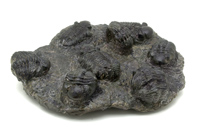 |
Amazing Fossil Trilobite Nest- Eight Full Size Adult Trilobites Together On The Same Musueum Quality Plate. Trilobites were among the earliest sea creatures, coming onto the scene long before dinosaurs. They did not swim, but crawled along the ocean floor in the manner of snails; they had the very useful ability to roll themselves into a ball as circumstances dictated. This particular species is known as Phacops and flourished during the Devonian time period about 400 million years ago. Excellent condition.
Estimated Value $500 - 600.
View details and enlarged photo
| Realized
$575 |
Lot 496 |
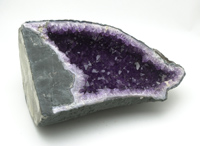 |
Amethyst "Cathedral" From Brazil. Absolute finest quality amethyst for clarity and color, enchantingly arrayed within one of the legendary "shimmering light cathedrals" from Brazil. This exquisite specimen, for the cabinet of a world-class gem connoisseur, stands about l3" tall, is 9 " wide and weighs just shy of 20 pounds; but size and weight are hardly a consideration, as the cathedrals are valued by SHAPE, COLOR, COMPOSITION, REGULARITY OF STONES, COMPLETENESS and other aesthetic factors--and on all counts, the present example scores very high marks.
The amethyst "cathedrals" begin as a concretion or ball of rock which shows nothing from the outside but a graining greenish/grey surface. They are machine drilled in half (sometimes quarters and eighths, etc.) to reveal the interior,and in the vast majority of instances, the results fall far short of repaying time and labor as the interior proves mediocre. Literally hundreds of concretions must be cut to discover an interior as perfect as on this specimen, and even then there may not be ideal or even marketable shape, in which event, the specimen will be totally broken up and the crystals used for jewelry.
Estimated Value $400 - 600.
View details and enlarged photo
| Unsold |
Lot 497 |
 |
Colossally Huge Ice-age Mammoth Tooth. This enormous 10-pound molar tooth of an American mammoth was found in Alaska many years ago (from an old collection). In terms of size, preservation, and visual appeal it is one of the most impressive specimens that could be imagined. Dark brown, almost black in color, with large portions of the roots still intact. Measures aboout 9" in length by 7" in height and 3 " thick. Mammoths flourished during the Ice Age or Pleistocene time period, which began about ome million years ago. It is believed that mammoths did not completely vanish until as recently as 10,000 years ago. Their extinction was primarily caused by hunting by early humans.
Estimated Value $450 - 600.
View details and enlarged photo
| Realized
$546 |
Lot 498 |
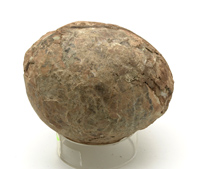 |
Duckbill Dinosaur Egg- From Madagascar. Very large (almost 11 pounds) perfectly preserved egg of the unusual and rare Duckbill Dinosaur, dating from the Cretaceous time period (apprroximatrely 100 to 150 million years ago). Wonderful and extremely scarce display item. Dinosaur eggs were virtually unknown, even in the most prestigeous musems, until expeditions began to the African and Mongolian deserets in the early 1900s. Even then, the rewards obtained for time and labor expended were meager at best. After World War II, China and Madagascar became further hunting grounds for dinosaur eggs, but political and other difficulties proved discouraging. As the vast majority of egg-hunting expeditions, regardless of locality, have been sponsored by museums, it is not surprising that the eggs so obtained have gone directly into those institutions with little or nothing reaching the public. Dinosaur eggs, especially of this size and quality, have been few on the market. A great opportunity!
Estimated Value $600 - 800.
View details and enlarged photo
| Realized
$863 |
Lot 499 |
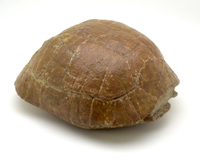 |
Enormous, Complete, Perfectly Preserved Fossil Turtle. One of the great showpiece specimens of the fossil world,a crowning glory for the collector who prides him (or her) self on "nothing but the best." The scientific name for this species is Geochelone and it can be found on page 230 of the Smithsonian's Fossils: Eyewitness Handbook. It will be noted, however, that the illustration shows a specimen (presumably the Smithsonian's best) considerably inferior to that now offered. In fact it would be impossible to find a better, if even an equal in all the world's museums. The shell, of an orange/brown color, just as the specimen bore in life, has not a single area of crushing,which is remarkable for fossil turtles (they are normally not only crushed in places, but completely splattered and/or fragmentary due to the weight of sedimental debris that entombed them prior to the fossilization process). Measures a full foot in length and is very heavy, due to the core or soft portions being replaced (over a very long period of years) by silt and sediment. This wonderful specimen, of the Eocene time period, came oout of an old Chinese collection and was collected in that nation many yearsa ago.
Estimated Value $1,250 - 1,500.
View details and enlarged photo
| Unsold |
Lot 500 |
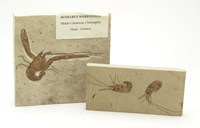 |
Fossil Lobster (Homarius Halkelensis) and Pair of Fossil Shrimp. Both items are from the Middle Cretaceous time period, from Haqel, Lebanon. Both of these fascinating specimens are not only perfectly preserved but bright, vibrant and gastronomically appealing, even after 125 million years. There were no hungry humans to avoid at that remote time, but, of course, plenty of predator fish to whom these tasty morsels were just as appealing as to today's gourmands. The detail and clarity of these specimens, both on closely-cut limestone slabs for display, are remarkable. The lobster has both claws extended, which is hardly ever the case with fossil examples, and each segment of the body is well defined. These must be seen to be believed!
Estimated Value $300 - 400.
View details and enlarged photo
| Realized
$546 |
Lot 501 |
 |
Fossil Oreodon Skull. This forerunner of the present-day sheep was a significant cog in the evolutionary chain. It appeared in the Eocene period, about 50 million years ago, when relatively small, fur-bearing, warm-blooded creatures had taken over domination of the earth from the dinosaurs, which had ruled without opposition for a period of some 150 million years. Quite possibly (though not an opinion that enjoys universal endorsement), there was a direct connection between the rise of the one and fall of the other, as mammals might have devoured the dinosaur's eggs prior to hatching and brought about their extinction. The Oreodon was a bit larger than a German Shepard dog. Being docile,and probably quite tasty, it was a favorite prey of the day's predators, but they could not succeed in wiping it out. Its genetics, and quite a bit else, went down into today's sheep.
This is a wonderfully preserved skull reattached to the original matrix, about 7 1/2" x 5", wdith an overall size, counting the matrix, of about 10" x 8". Nearly all of the teeth are not only present, but so clearly defined that the original contrast in coloration between the portion gumline and below gumline is still present. Collected in Montana many years ago.
Estimated Value $550 - 650.
View details and enlarged photo
| Realized
$633 |
Lot 502 |
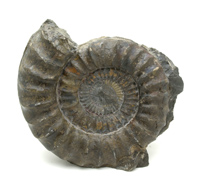 |
Giant Display Fossil Ammonite, Of a Type That Seldom Attains Such Prodigious Size. This extraordinary beauty could almost be called one-of-a-kind in terms of its size, definition, color and unrivaled state preservation. The scientific name is Astereoceras. This magnificent specimen was found in England and dates from the early Jurassic time period, when larger dinosaurs were just coming upon earth, close to 200 million years ago. It was a bottom-dwelling sea creature which had soft or living parts much like the squid of today. A major characteristic of this species is the prominence of the rib projections and their sloping contour (see page 154 of the Smithsonian guide to fossils). The diameter is 10"--very heavy!
Estimated Value $350 - 450.
View details and enlarged photo
| Unsold |
Lot 503 |
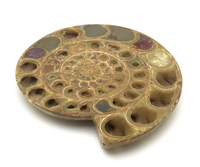 |
Halved And Polished Giant Ammonite Shell. This is not only a specimen of real beauty on the outside, but has been carefully and expertly sliced in half lengthwise, then highly polished to reveal a fascinating myriad of siphuncle joining chambers,concave/convex chambers, curved sutures, chamber walls, etc., in a vast, eye-dazzling mixture of shapes and colors. This ammonite is of the family Echioceras and dates from 200 million years ago. The size is 11". Condition is superb!
Estimated Value $350 - 450.
View details and enlarged photo
| Unsold |
Lot 504 |
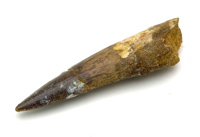 |
Large Dinosaur Tooth. Very attractive 35/8" specimen of a DEADLY looking tooth from Spinosaurus, a late Cretaceous-era dinosaur. Found in Egypt. While dinosaur bones are traded on the market in varying quantities (mostly,however, in ugly fragments not so appealing to collectors}, teethof ANY kind in ANY condition grade are scarce. This is not juatr for the obvious reason that dinosaurs, like people had a lot more bones than teeth. The fact that teeth were exposed, not covered by skin, tissue, etvc. normally caused their deteriration at a much faster rate than bones. Also, many dinosaurs were not the megalithic Hollywood versions but actually quite compact creatures and had SMALL teethto match their small bodies. A 3 5/8 dinosaur toothis not to be met with frequently. This specimen, which has an unnoticeable repair, is enclosed in a frame with descriptive text at top. Quite a piece.
Estimated Value $350 - 450.
View details and enlarged photo
| Unsold |
Lot 505 |
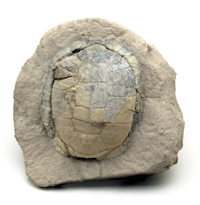 |
Magnificently Preserved Showpiece Fossil Turtle. Species Columbia taunicum from the Oligocene time period (about 20 million years ago). This highly exquisite specimen was unearthed at Kontchekusu, Russia. Not only is this collector's treasure fully intact without missing portions, which is rare in itself, but there is no crushing or flattening to any poretion of the shell, which is almost unheard of in turtle fossils. Measures about 4 3/4" by 3 3/4"' in the original sandstone matrix which has been carefully shaped to provide for optimum visual appeal when displayed. Overalll size including matrix about 6" x 6" with varying thickness.
The vast majority of fossil turtle shells, regardless of size, are found with some degree of crushing due to the soft body parts. Shells without crushoing, such as this, are the elite of their class.
Estimated Value $450 - 600.
View details and enlarged photo
| Realized
$518 |
Lot 506 |
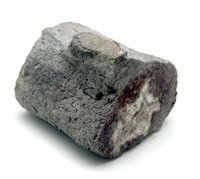 |
Massive And Stunning Dinosaur Bone. Perfectly preserved agatized bone specimen from the Jurassic period, found many years ago in Wyoming prior to the ban on fossil hunting on national parkland. About as fine as they come, for symmetry, color and condition. Outside, a beautifully textured grey with undulating ridges, accented in subtle shades of brown and henna; inside (visible at both ends,where the specimen has been expertly sliced) a very striking and exceptionally rare "marrow bone" appearance. This comprises a heavy layer of red encircling a central component of white marble-like substance. It would not be overstating to say that fewer than five in 10,000 dinosaur bone specimens preserve in so graphic a manner, as the conditions necessary for this seldom existed. Weight, about ten pounds.
Estimated Value $350 - 450.
View details and enlarged photo
| Realized
$518 |
Lot 507 |
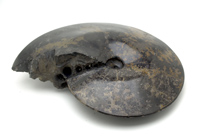 |
Rare Placenticeras Ammonite. A colossal specimen, featuring a glossy metallic-like finish in varying shades of grey, brown, silver, etc. It dates to the Late Cretaceous period. In the Smithsonian fossil guide, this species is stated to be found up to a maximum size of 9 inches. This one is more than 15", or better than half a foot larger than the supposed largest known. It would be most difficult, if not impossible, to find a larger, more eye-appealing or better preserved example of this very impressive fossil. A great display piece.
Estimated Value $600 - 800.
View details and enlarged photo
| Realized
$920 |
Lot 508 |
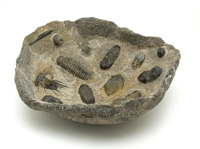 |
Rare Trilobite "Nest" Comprising Several Different Species. Fossilized specimens of fifteen trilobites plus a belemite, all on the same plate and arranged in a symmetrical manner. Predominant among the specimens are adult and juvenile Phacops but several others can be readily distinguished even by the non-scientific eye, including a literally magnificent example of the highly prized "spider trilobite," plus a totally recoiled trilobite, plus a belemite or sea snake, a creature from which the modern squid evolved. About 13" by 12" by several inches deep.
Estimated Value $650 - 800.
View details and enlarged photo
| Realized
$748 |
|
|